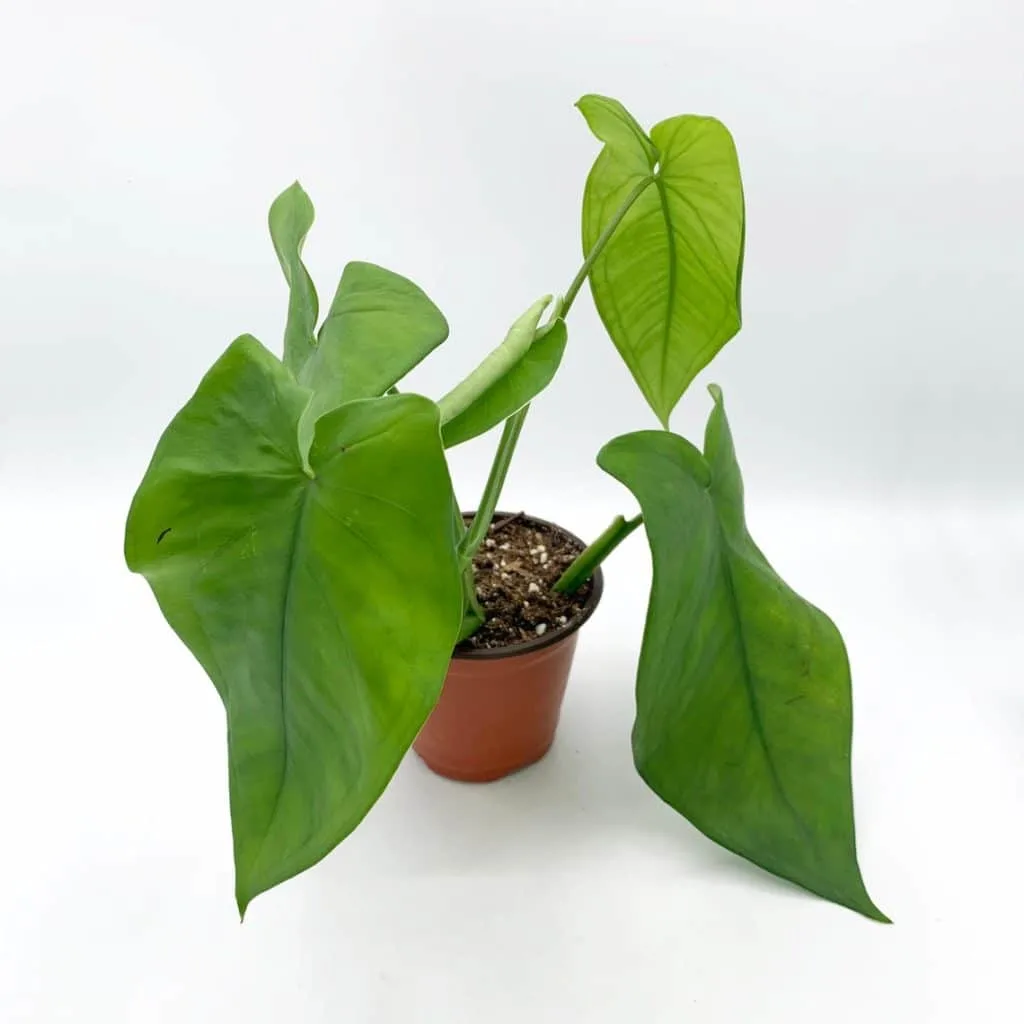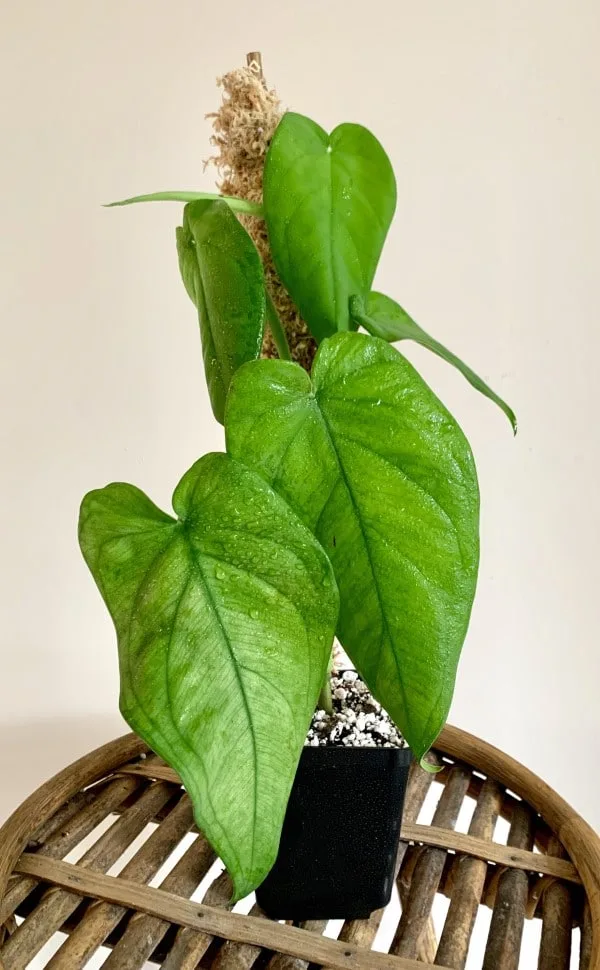Syngonium Macrophyllum is an easy-to-grow plant from the Araceae family. The leaf is much different from other species because it has a bit of a rubber texture when mature.
The foliage has an odd color, greener to glaucous, which is not often seen in collections. Unlike other species, the foliage also does not segment or split as it matures.
The leaves have a hastate look, and the plant can get over 2 feet long. The petioles are often a light blue, green color with a white powder-like substance. The plant is well-rooted in a 6-inch pot and should be potted up in something larger and allowed to climb.

Care tips for Syngonium Macrophyllum
1. Lighting
The Syngonium Macrophyllum, like most decorative leafy crops, does not tolerate direct sunlight. Therefore, it should be placed on the eastern and western windowsills with light shading during the hot midday hours.
It is permissible to grow a plant on the northern windows, but this reduces the leaves’ variegation and slows down growth.
The plant feels great on unique stands near the window, which eliminates the appearance of burns under the influence of ultraviolet radiation. Also, it improves its decorative effect.
2. Temperature
Syngonium Macrophyllum is a heat-loving vine, and the temperature regime should vary between 18 and 30 degrees Celsius in summer and about 18 degrees in winter.
The plant can withstand a slight decrease in temperature if gradual and short-lived. For Syngonium Macrophyllum, about 17 degrees Celsius is considered critical. It contributes to the development of irreversible processes in the tissues, leading to the plant’s withering with further death.
3. Watering
Abundant watering is the primary condition for the successful cultivation of Syngonium Macrophyllum. The irrigation frequency should not lead to drying the top layer deeper than 3 cm.
In spring and summer, watering should be carried out one time in 3 days, allowing the substrate to nourish the required amount of moisture.
To do this, after watering, the water from the pan should not be poured out for the next 2 hours. It is recommended to water the Syngonium Macrophyllum once every five days in autumn and winter.
4. Humidity
High humidity is also vital for the Syngonium Macrophyllum. Therefore, the leaves should be sprayed with settled water at room temperature in between water.
In the hot season, to increase humidity, it is recommended to place containers filled with water near the pot, which will increase the evaporation area.
And put the pot itself in a cache-pot, on the bottom of which lay a layer of expanded clay 2 cm thick. Pour water into it so that the pot’s base does not touch the water. This will avoid overheating the root system and provide the plant with the necessary moisture.
5. Fertilizer
The Syngonium Macrophyllum needs to be fed with liquid mineral fertilizers for decorative leafy plants with a low calcium content from April to September. This should be once every two to three weeks. In winter, the plant does not need top dressing.
6. Top dressing
For the Syngonium Macrophyllum to fully develop and give annual growth, it should be fed during the active phases of development. For this, fertilizers for decorative leafy plants are used sold in flower shops.
Frequency of fertilizer application: from the end of February to the beginning of September – 1 time in 10 days. From mid-September to mid-February – 1 time in 3-4 weeks. Lack of nutrition leads to slow growth of shoots and a decrease in leaf blades’ size.
7. Transfer
Caring for Syngonium Macrophyllum involves timely plant transplantation. Young vines are transplanted every spring and those that are older.
This is after two or three years when roots appear from the pot’s drain hole. Syngonium soil needs loose, water and breathable, neutral or slightly acid reaction – pH 6-7.
There is a need for an approximate composition suitable for growing a Syngonium Macrophyllum, including one part of sod, leafy soil, peat, and sand.

Propagation methods
a) Propagation by apical cuttings
Propagation by apical cuttings is a reasonably popular method. To do this, cut off a part of the plant 10-15 cm long, keeping several internodes with aerial roots.
The prepared material is placed in warm, settled water until roots form. Before, a tablet of activated charcoal was dissolved in water. After forming the rhizome, the plant is transplanted to a permanent place.
b) Propagation by rooting
There is another approach to propagation, which involves rooting a piece of the stem. The prepared container is filled with expanded clay and loose soil.
The pot is placed near the vine, and the stem part is added dropwise, securing with a paper clip. Watering and fertilizing are carried out as needed. After 14 days, the rooted shoot is separated from the mother plant.
Pests and diseases
When you talk about the pests that attack Syngonium Macrophyllum, aphids, thrips, and scale insects are dangerous in the first place. As a result of the vital activity of these pests, the plant loses its decorative effect.
Also, the leaves turn yellow, deform, dry, and fall off, and the plant itself slows down or even stops growing. To combat these pests, spraying the Syngonium Macrophyllum with solutions of drugs such as fit over, actellik, or decis is used in the ratio indicated in the instructions.
Syngonium Macrophyllum can also turn yellow from insect attacks, but sometimes from a lack of nutrients in the soil. The appearance of too small and discolored leaves also indicates this.
If the Syngonium Macrophyllum darkens and the leaves’ tips dry, the leaves fall off. This signals that the air in the room is too dry.
And when you get carried away with moisturizing the Syngonium, the plant’s leaves become dull and dull. Leaves fade even when the plant lacks light.
Conclusion
One of the most common species in room culture is Syngonium Macrophyllum. The plant has large, emerald green heart-shaped leaves on long petioles.
The surface of the sheet plates is glossy. The Syngonium Macrophyllum produces a pink inflorescence surrounded by a pink veil during the flowering period.
